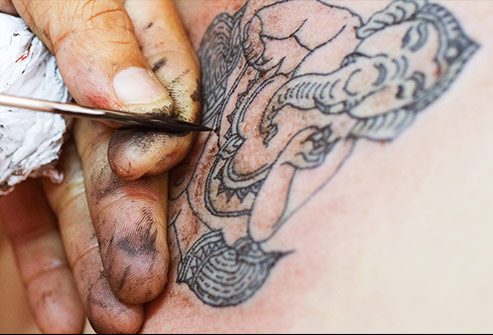Rethink Your Ink
Tattoos have been around for thousands of years, but they’ve really gone mainstream in the last decade or so. No matter how advanced the technology gets, it still amounts to a puncture wound filled with ink. And for some people, that can cause problems, from allergic reactions to infections and more.
Allergic Reactions
Some tattoo dyes, especially red, can cause an allergic reaction. The area around your tattoo might itch or swell, or you could get a rash. It can happen right after you get the tattoo, or years later. If it’s mild -- itchy skin and a few bumps -- treat it with a steroid cream. If your reaction is worse or if doesn’t go away in a couple of weeks, call your doctor.
Reactions to Light
Some ink reacts to light, especially sunlight. So if you don’t keep a new tattoo covered for a couple of weeks, your skin can swell or turn red. This is most common with yellow inks, but it can happen with red, too. Again, a mild case should get better with time and antihistamines or steroid creams, but if not, check with your doctor.
Skin Infections
If your tattoo artist doesn’t properly clean his equipment or uses it on more than one person, you could get an infection. If your skin swells, turns red, or feels tender, or you notice a pus-like drainage from the tattoo, call the doctor. You may need antibiotics to clear it up.
Red burn back......
Granulomas
Sometimes your immune system thinks the pigment in tattoo ink is a threat and sends cells to the area to fight it. These cells clump together around the tattoo and create nodules which are called granulomas. If you see them, talk to your doctor. He might run tests to rule out other causes. He’ll treat them with steroids -- taken by mouth or as a shot.
Keloids

Keloids are areas of scar tissue that are raised from the skin. They can start under the tattoo and spread out. Keloids run in families and are more likely to affect people with dark skin. Treatment starts with steroids, but it can get involved after that, and the keloid could come back. If you have them already or someone in your family does, you might want to avoid tattoos.
Blood-borne Diseases
Tattoo needles get bloody. If yours wasn’t cleaned well between uses, you could be exposed to diseases spread by blood, like hepatitis B or C, tetanus, or HIV. Choose your tattoo artist wisely. Make sure needles and other instruments are sterilized and that your artist wears gloves.
MRI Complications
You may notice that a tattooed area swells or burns when you get an MRI. This is rare and usually goes away without causing problems. Tell your radiologist or technician about your tattoos so they can take precautions. Your skin might not react, but the MRI could affect the quality of the image.
Problems With Removal
If an allergic reaction or infection doesn’t clear up -- or if you just hate the tattoo -- you can have it removed. Laser removal technology has gotten better, but it isn’t perfect. It rarely leaves scars, but it can change your skin’s texture or color, especially if you have a darker tone. And it can cause what was a local reaction to spread.
Check out other post on this blog; you would love them.
Comments are welcomed!
Happy Reading!







No comments:
Post a Comment